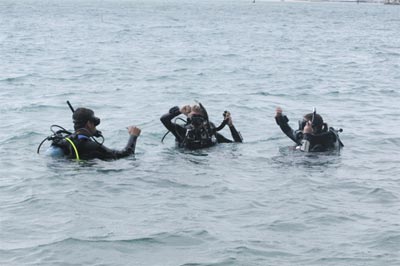Think Like a Divemaster

Location of Divers – It’s important to know where your divers are at all times to keep the group together and not leave anyone behind. You can manage the location of the divers you are leading by checking in with them often and conducting a mental head count throughout the dive. The divers should be aware of where you will be in the water prior to descending, which can be communicated during a proper predive briefing. A trick from the pros – Stay on task! Focus on your main objective: safely lead a group of divers and keep them together. Searching for critters and things to point out should not be your main goal for the dive. It can cause you to become distracted from the group, allowing for separation. Stay on task and focus on the divers.
Speed – Often overlooked, the Divemasters swimming rate can make or break the dive. Most divers do not want to chase their DM. It’s important for Divemasters to take their time in the water, allowing their divers to relax and enjoy their experience. A trick from the pros – If you think you’re going too slow, go slower! After the dive, ask your divers if that speed was okay. They will let you know to speed it up or slow it down.
Available Breathing Gas – When leading a dive, not only does the Divemaster need to be aware of how much breathing gas he or she may have, they also need to know how much their divers have as well. An essential step in the predive briefing is to cover when the dive will be turned around, whether you are basing your turn around point off the “rule of thirds” or when half of their available gas is consumed. It is crucial that underwater communication is covered during the predive briefing to achieve this goal and get everyone out of the water safely with available reserve gas. A trick from the pros – “spy” on how much breathing gas your divers have! You can do this by looking at their gauges while they are swimming or focused on something else in the water. You can also combine your head counts with asking your divers how much air they have.
Available Bottom Time – Have you been diving all day? Have your divers been diving all day? Is everyone breathing the same gas? It’s crucial to know where everyone stands on available bottom time throughout the dive so no one exceeds their nitrogen absorption limits for that dive. If different groups are going to dive at different levels or if the dive needs to be shallower to increase overall diver safety then brief and lead the dive that way. If you have divers breathing various nitrox mixes, it’s good to know who can stay down longer and who cannot. A trick from the pros – Make sure available bottom time and gas mixtures are discussed prior to entering the water. Establish a plan for the group and stick to it. This is a great example to demonstrate why it is important for every diver to have their own computer.
Exit – It’s a gut wrenching feeling to turn the dive around and not know where the boat is or how to get back to your original entrance point on shore. During the dive, it’s important for DMs to pay close attention to their surroundings and take mental notes on how to get back to where they started. You might find using a compass works or basing your dive on natural navigation. DMs often turn around to take a look at the scenery from the point of view they will see on their return. A trick from the pros – If you’re returning to a boat in a fixed position, make note of the depth and compass heading in the direction back to the boat. If you’re returning to a fixed position on shore, before going on your dive tour, take a compass heading toward shore, make note of the depth and if there is sand in the area simply draw a X in the sand to mark your spot of return. Does that guarantee it will be there upon your return? Of course not, but that little trick might help you somewhere down the line!
If you didn’t notice, the top five points the DMs made have some similarities; proper dive planning and communication prior to entering the water can reduce the event of some confusion during the dive. Always remember to plan your dive, dive your plan! Use these tricks and tips to help you lead better dives.
Contact SDI TDI and ERDI
If you would like more information, please contact our World Headquarters or your Regional Office.
Tel: 888.778.9073 | 207.729.4201
Email: Worldhq@tdisdi.com
Web: https://www.tdisdi.com
Facebook: www.facebook.com/TechnicalDivingInt

اترك رداً
تريد المشاركة في هذا النقاششارك إن أردت
لا تتردد في المساهمة!